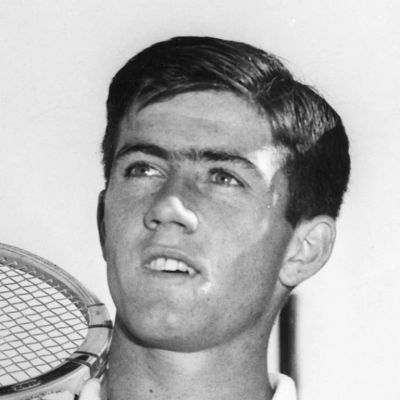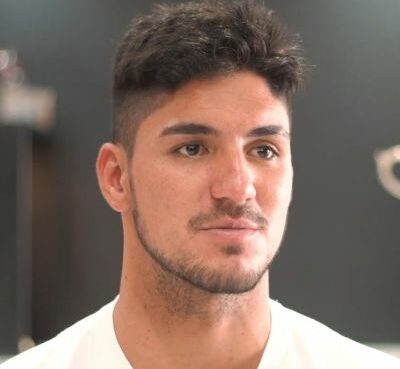Ken Rosewall is an Australian tennis player. Ken Rosewall began playing earlier than other athletes and declared his retirement later than his peers. Ken acted as a squash instructor on the tennis court in addition to being a player.
Despite his willingness to participate in retirement, he had won over many young athletes.
Ken, who came in first place, had an incredible amount of energy to perform in the humid Australian air.
Table of Contents
Early Years
Ken Rosewall was born in Hurstville, Sydney, on November 2, 1934.
Ken was raised in Penshurst, New South Wales, by his mother Vera Rosewell and father Robert Rosewall, a grocer.
They later relocated to Rockdale. Because Ken’s father Robert was a tennis enthusiast, he made the clay tennis court available to him.
Ken began playing with shortened rackets when he was three years old.
Ken got into it day by day, despite using both hands for forehand and backhand shots.
Ken was born right-handed, but his father forced him to utilize it the most.
With practice, Ken developed a powerful and effective backhand as well as a perfectly precise and relatively soft serve.
Ken attended Kogarah High School in Kogarah, Australia, for his education.
Facts of Ken Rosewall
| Full Name | Kenneth Robert Rosewall |
| Known as | Ken Rosewall |
| Nickname | Muscles |
| Birth Date | 2nd November 1934 |
| Birth Place | Hurstville, Sydney, Australia |
| Residence | Turramurra, New South Wales, Australia |
| Religion | Christian |
| Nationality | Australian |
| Ethnicity | N/A |
| Education | Kogarah High School in Kogarah, Australia |
| Horoscope | Scorpio |
| Father’s Name | Robert Rosewall |
| Mother’s Name | Vera Rosewall |
| Siblings | N/A |
| Age | 87 years old |
| Height | 5’7″ (170 cm) |
| Weight | 68 kg (150 lb) |
| Eye Color | Brown |
| Hair Color | Grey |
| Body type | Athletic |
| Profession | Tennis Player |
| Marital Status | Married |
| Spouse | Wilma Mclver |
| Children | 1 |
| Name of Children | Glenn Rosewall |
| Beginning of Professional Career | 1945 |
| Retirement | 1982 |
| Playing style | Right-handed (one-handed backhand) |
| Sports team | N/A |
| Coach | N/A |
| Honors | Appointed as a member of the order of the British Empire (MBE) (1980), Appointed as a member of the order of Australia (1979), Inducted into the International Tennis Hall of Fame in Newport (1980), inducted into the Sport Australia Hall of Fame (1985) |
| Victory | N/A |
| Net Worth | $15 million |
| Prize Money | N/A |
| Merch | Sportscaster Card, Muscles: The Story of Ken Rosewall(Book), Tennis HOF Signed Card |
| Last Update | May 2022 |
Net Worth
Ken Rosewall’s net worth is estimated to be $15 million, but the exact net worth is not recorded for now.
Early Career
Ken began playing tennis at the age of nine, having a natural talent for the sport.
Ken won the Metropolitan Hardcourt Championships under 14 groups at the age of eleven.
Despite their physical differences and playing styles, Ken and Lew Hoad were known as Sydney’s “twins” for a while.
Ken and Lew both played their first match at the age of 12 in Sydney in 1947.
They eventually played as part of an exhibition match between Australia and the United States.
Ken became a hard-hitting adversary as he gained knowledge and time in the courtroom.
Ken won the junior championship in the Australian Hardcourt Championships in Sydney in 1949 when he was 14 years old.
Ken was also the youngest player to win the championship.
Amateur Work
Ken had previously qualified for the New South Wales Metropolitan hard court championships and the New South Wales Metropolitan grass-court semi-finals in 1950.
In 1951, Ken won his first men’s competition as the youngest player, defeating Gilchrist.
Ken was progressing, attempting to better himself despite missing a few of the match’s smashes.
Aside from that, he played almost flawlessly.
Ken advanced to the semi-finals of the Brisbane exhibition event the following year, losing to Lew Hoad.
He also lost in the final of the Metropolitan Hardcourt Championships to George Worthing.
Ken then advanced to the quarterfinals of the US Championships at the age of 17.
Ken won his first Grand Slam at the age of 18, in the Australian Championships final, as a singles player.
He also won the French Championships with all of his flawless shots against Seixas.
Ken was also widely predicted to win Wimbledon, but he fell short in the quarterfinals.
In fact, Ken defeated Trabert and Seixas in 1953, albeit in separate matches.
As a result, the editor of Tennis de France magazine ranked Ken third overall for the 1953 season, after Hoad and Trabert.
As a result, Ken defeated Trabert in the Wimbledon semifinals later on. Later, he lost in the final to Jaroslav Drobny, a fan favorite.
He did, however, lose in the semi-finals of the United States Championships.
He was unable to compete in the French Championships in 1955 due to the Australian Davis Cup team.
Lew Hoad, Gonzales, and Laver’s relationship
Ken and Hoad started their careers at the same time since they were so young.
In the meantime, they defeated each other more than any other player.
Despite their differing playing styles and speeds, they were dubbed “Twins” or “The Gold Dust Twins.”
They had to confront each other for a shorter period of time, even before both of their professional careers, from every match to the conclusion.
They were defeated in Grand Slams, Wimbledon, and the Australian Championships on numerous occasions.
Editors or rankers usually ranked them one after the other in line with the world’s best.
Ken also played at least 182 matches with Gonzales, all of which were professional.
Laver’s meetings, on the other hand, are better documented and thorough.
He also won 85 and lost 116 matches versus Gonzales, and played 135 matches against Lew Hoad, winning 84 of them.
Professional Tennis Career
Despite the fact that both Ken and Hod accepted Jack Krammer’s professional contracts in late 1955, only Ken signed them in late 1956.
He bravely competed on the tour for a decade after declaring himself a professional player.
He won eight French Pro-Championships (1958, 1960-68), five Wembley Pro-Championships (1957, 1960-63), and two US Pro-Championships (1963, 1965).
Ken’s inability to compete in large tournaments was removed by his decision to become adept.
Rosewall won the primary accessible major at the French Open, defeating Laver 6-3, 6-1, 2-6, 6-2, when Open tennis made a huge comeback in 1968.
Furthermore, the duo’s play in 1971 and 1972 made Ken a household name, particularly in the World Championship of Tennis.
Ken even won the nice $50,000 prize pool while playing in Dallas.
The most intriguing match in Ken’s career was against Laver, who he defeated with a score of 4-6, 6-0, 6-3, 6-7, 7-6.
The game was broadcast on television for three and a half hours and was seen by millions. With a lot of bread and butter strokes, the last tiebreaker was decided by two massive backhand returns.
Perhaps both players were exhausted, but they agreed not to quit up; there were ten easy points to be had. Ken, for one, had not expected anything like that to happen, despite his best efforts.
Ken also won several Australian titles, as well as French, Wimbledon, and US Open titles.
As a result, Ken won a total of 133 tournaments, maintaining his world number one ranking multiple times.
Career Opportunities
In 1972, the US Open established the Association of Tennis Professionals (ATP), which allowed players to compete in almost any tournament they wanted.
He won seven tournaments in his first year, becoming the oldest Grand Slam male singles champion in the open era.
Ken suffered the worst defeat of his career during the same ATP year. Additionally, he received only two minor titles.
Since the beginning of his career, 1974 was the only year Ken did not win any tournament.
Despite having strong cheers from the crowd, he lost the Wimbledon title to Jimmy Connors.

Keeping aside the actual age, Ken gave continuity to tennis. In 1974, he even coached the Pittsburgh Triangles.
Meanwhile, Ken gave his last try at Wimbledon at 40 but still lost against the same player.
With his climbing age, his ranking position of Ken also kept on slipping. In 1977, Ken again made up to the top 20, winning a few tournaments.
Further, at the age of 46, Ken still defeated American Butch Walts and ranked World No. 49.
Undoubtedly, every core of his body was dying for his retirement, but then again, in 1982, he made his participated in South Wales Hardcourt Championships in Grafton.
As expected, he lost to Brett Edwards in the final two sets.
Playing Style and Assessment
Maintaining one of the longest tennis careers, Ken Rosewell remained virtually injury-free, energetic, and still made up to tournaments at 43.
Meanwhile, Kramer included him on his list of the 21 greatest players of all time.
Ken is a person to rank 13 among all-time male tennis players according to the 2012 Tennis Channel series “100 Greatest of All Time.z
Personal Life & Wife
Besides world records, matches, and stats, Ken Rosewall was married to Wilma Mclver.
The two lovebirds tied the knot on 6th October 1956 at St. John’s Cathedral, Brisbane.
Afterward, the couple resided in Turramurra, New South Wales.
Later on 27th April 2020, his wife’s sudden death shocked him to the core.
Meanwhile, Ken Rosewall was a non-Executive Director of the failed stockbroking firm BBY.
He also has a son Glenn Rosewall, the company’s Executive Director.
Also Read: Urban Meyer, Darren Collison Charley Casserly
Honors and Achievement
In 1971, on the day of the Queen’s Birthday, Ken was awarded a Member of the Order of the British Empire (MBE).
Then, in 1979, Ken was appointed as a Member of the Order of Australia.
Similarly, in 1980, Ken was inducted into the International Tennis Hall of Fame in Newport, Rhode Island.
Moving onto 1985, he was inducted into the Sport Australia Hall of Fame.
In fact, the Sydney Olympic Park Tennis Centre’s central court is named Ken’s arena.




